
MODULE 8 - SETTING UP FOR ELK
CHAPTER 1: GET IN "THE ZONE"

Before you transition from the “Locating” phase into the “Setup” phase, it’s important to gather as much information as possible before you start your approach. During this transition, you want to understand as much as you possibly can about the situation in a very short amount of time. If the elk responds to your location bugle very aggressively – and he is close – you might not have much time at all. You might be forced to scramble just to find a suitable setup and get your bow drawn before the bull storms in. However, in most cases, you will be able to make a controlled and patient plan for your approach.
CREATE A GAME PLAN
There are a lot of factors that can complicate this phase of quickly gathering information: elk on the move, changing thermals, unresponsive elk, etc. One of the first things I try to determine is whether or not the elk is on the move. Most times, they are, so it can be very helpful to understand where they are going. If the bull isn’t running in to your location calls, where is he going? Is he with a herd that is slowly feeding their way back to their bedding area? Are they close to their bedding area and just milling around waiting for the thermals to switch? Is the bull aggressive or timid? Am I going to have to pull him away from his cows? What distinguishable landmarks are there near the bull that will help guide me in closer? How long is it going to take me to get close enough to start calling? What is the wind doing and what will the wind be doing when I get close to the bull? All of these questions, and many more need to be going through your mind as you analyze the best approach to get in as close as you can.
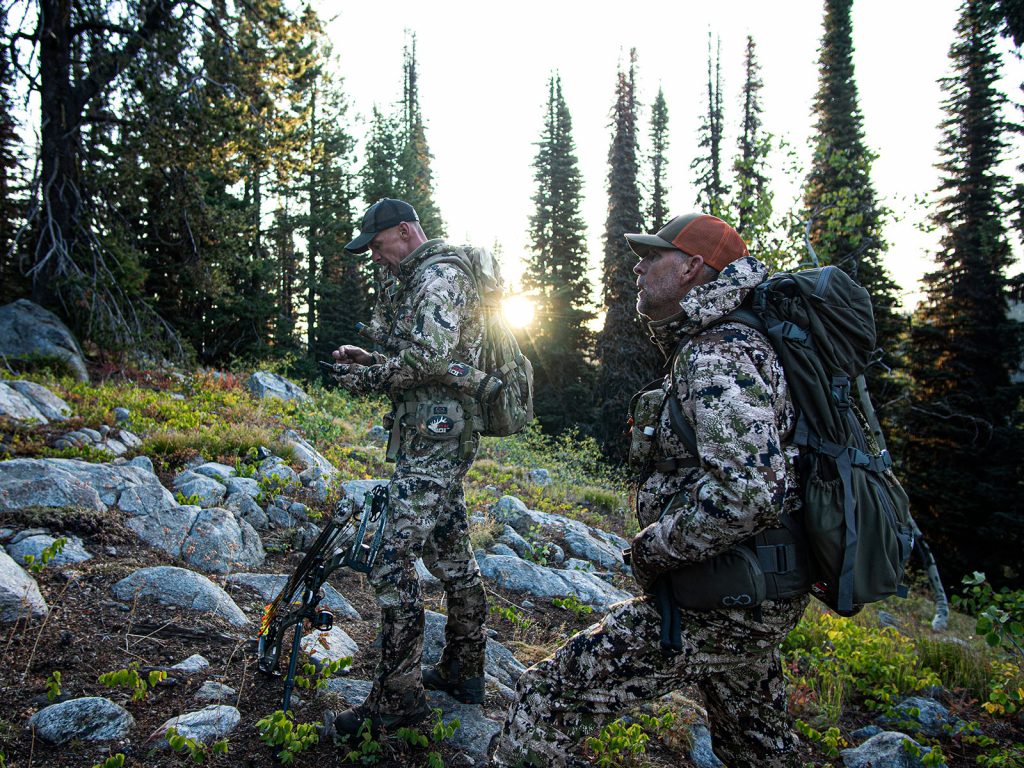
You might determine that with the terrain and the impending thermal switch, it may be best to back out and wait. Or, you might determine that you need to move swiftly and make it happen before the bull makes it to an area where you will have little or no chance at getting close to him. Once you have assessed the situation and created a game plan, you need to make your move. Hopefully, during this time, the bull has continued to call on his own, which makes it really easy for you to slip in close and keep accurate tabs on the bull’s location. Unfortunately, this is not always the case. From time to time, I am forced to call to the elk during my approach to more accurately pinpoint his location. If I need to do that, I will almost always use just a cow call. While I may be giving up the full element of surprise, if I can keep the bull from knowing another bull is coming towards him, I can use that to my advantage once I get set up and start calling.
From here, it is simple. Don’t confuse that statement with easy….it’s certainly not easy. However, I simply want to get as close to the elk as I can, as quickly as I can, without him knowing I’m coming. This requires great attention to the sounds you are making, as well as your visibility as you move in. I hope by this point, I don’t need to stress how important it is to make sure the wind is not moving from you to the elk. Do whatever it takes to make sure the thermals are not going towards the elk, even in the slightest.
At some points during the hunt, it’s totally OK to make natural noises. However, as you are approaching a setup, it is not OK. If an elk hears a branch snap or a rock roll, he will know something is there, and you have lost the element of surprise. At this point, you will need to give a cow call so he knows it isn’t danger, but he will now know that you are moving his way, which isn’t ideal. It certainly doesn’t mean he is going to get nervous and leave, but not having the element of surprise is going to be a disadvantage once you get set up and start calling.
FINDING THE PERFECT SETUP
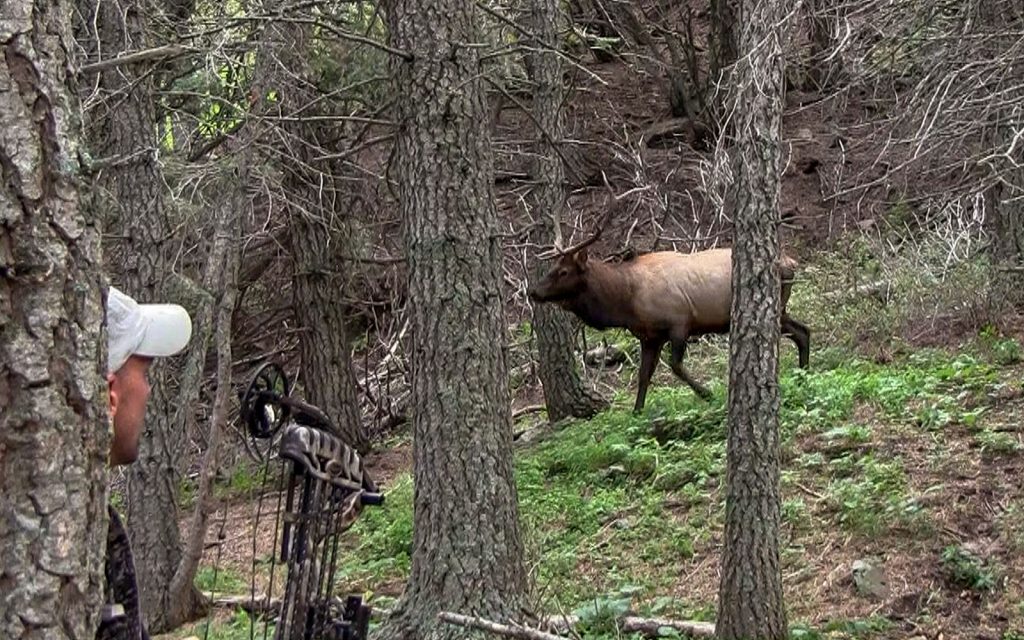
You are now on the move, and working to get close to the bull. If the bull has decided to come in to your original calls, you are going to need to work a little faster to find a good setup.
Regardless, it will do you no good to set up in an area that offers little or no chance of success.
I bolded that sentence for a very good reason. If things are happening fast and I know I am in a terrible setup, I will take some calculated risks to get into a better location where I have a chance of being successful. If I am in control of the situation and silently moving in on the bull, I can take a few extra seconds to find a setup that will be more conducive to a successful call-in. And that is going to be vital.
Imagine a T-shirt that lists all the excuses for why your previous elk hunt failed: ‘I hit a limb, The bull stopped behind a tree, I misjudged the distance, The bull hung up at 80 yards, The wind switched’. The list can be quite extensive, and in my experience, most of these excuses are realized during the setup, more so than just about any other period of the hunt.
Perhaps the biggest obstacle we face when setting up on an elk is the factor of dynamics – when you’re hunting elk, they’re typically on the move. Oftentimes, you don’t get to pick the setup – the setup picks you. Learning to be a little more selective in your setups, however, as well as understanding the conditions that lead to a successful setup, could be the deciding factor for success.
CONSIDER THE ELK’S SENSES
When an elk feels like it is able to maintain control and utilize its senses to detect danger, it’s going to feel more comfortable approaching a calling setup. If it’s not comfortable, it’s probably not coming closer. Consider the elk’s senses – sight, sound, and smell – and use them to your advantage in a way that makes the bull feel like he is protected by them. Sound – If a bull is coming toward your setup and you make a sound, he will likely pinpoint that location, even if the sound you made was natural (elk bugle, branch breaking, etc). When he gets to the point where he can see the location of the sound, he will scan the area and look for the source. Making a sound isn’t necessarily a bad thing, unless the elk can see the location of the noise and not see the source of the noise. Unidentified sounds make elk nervous. Always be as quiet as you can when you are setting up. If the bull hears a branch break, he will remember that location as he approaches. Clear the area of dead branches and debris. If your knee crunches a pine cone as you shift your weight to draw your bow, the elk will hear the sound and pinpoint the location. I’m going to go into a lot more detail on the two-person setup (caller/shooter) in just a little bit, but for now, just remember that a caller can get away with more noise (raking trees, calling, etc.). If you are a shooter set up out in front of a caller, you don’t want to make any noise. If you do, always remember that the bull will know exactly where you are. Sight – When it comes to an elk’s sense of sight in your setup, there are two main keys you want to remember. First, break up your outline so the elk doesn’t immediately pick you out, and second, avoiding making any detectable movements. It’s important to set up in an area where you can conceal your outline and movement, and still have multiple, clear shooting lanes. While too much cover will conceal you well, it will usually limit – or even eliminate – your shooting lanes (i.e., setting up behind a tree or in the middle of thick brush patch). Too little cover will leave you exposed and allow the elk to pick you out, possibly before you even make any movement (i.e., setting up in the middle of a meadow). It’s important to set up where there is ample cover behind you to break up your outline, as well as sparse cover along your shooting lanes to allow you to draw your bow when the elk passes behind it.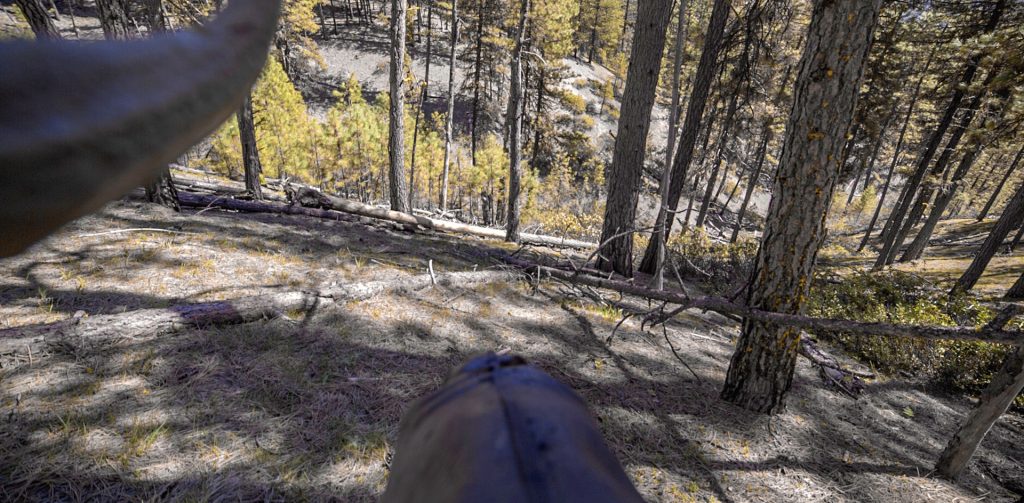
This is what an elk sees when it comes into your setup. Can you spot the shooter?
When I set up, I usually prefer to stand as it allows me more mobility with less movement. The downside is that I am now 6 feet above the ground rather than 3 feet. This makes it easier for the elk to spot me, so having a good backdrop to conceal my outline is vital. When you kneel down, you aren’t as visible, but you sometimes limit your shooting lanes. Again, I prefer to stand, but each setup is going to dictate which position – standing or kneeling – is going to be best.
The movement of drawing your bow can be the most difficult obstacle to overcome in a good setup. Be sure that you move only when the elk’s eyes are hidden from your view. If his head is turned, or when he walks behind a tree or brush, those can be perfect opportunities to come to full draw. Always make sure that your movements are not fast, but rather, slow and smooth.
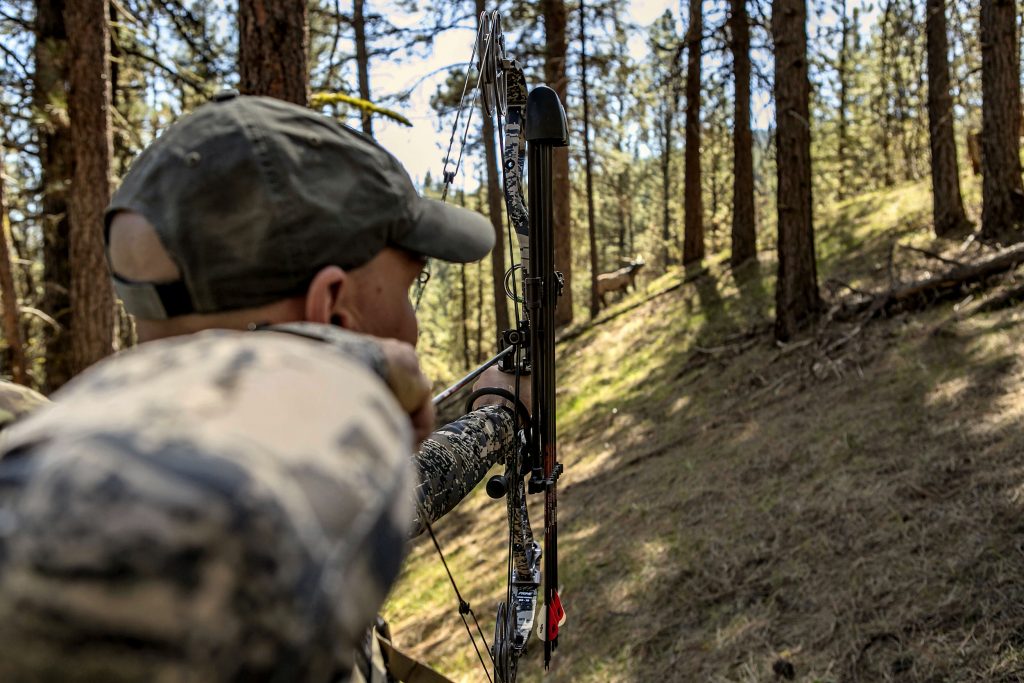
Terrain and vegetation will often determine when you should draw your bow. If you’re hunting in open terrain, it might be necessary to draw early and hold at full draw for longer times as the bull moves closer. Or, in thicker vegetation, you might need to predict when the bull will step into your lane and draw based upon hearing branches breaking or other indicators that will alert you to his approach.
Additionally, keep in mind that an elk’s field of vision spans a full 270 degrees! With eyes located on the side of their head, elk can see quite a bit of what’s going on behind them without even turning their head. With a slight turn of their head, they have a full 360 degree view. This means an elk can spot the slightest movement, even when they seem like they are past you and not able to see you. If you can see an elk’s eyes, the elk can see you and your movement.
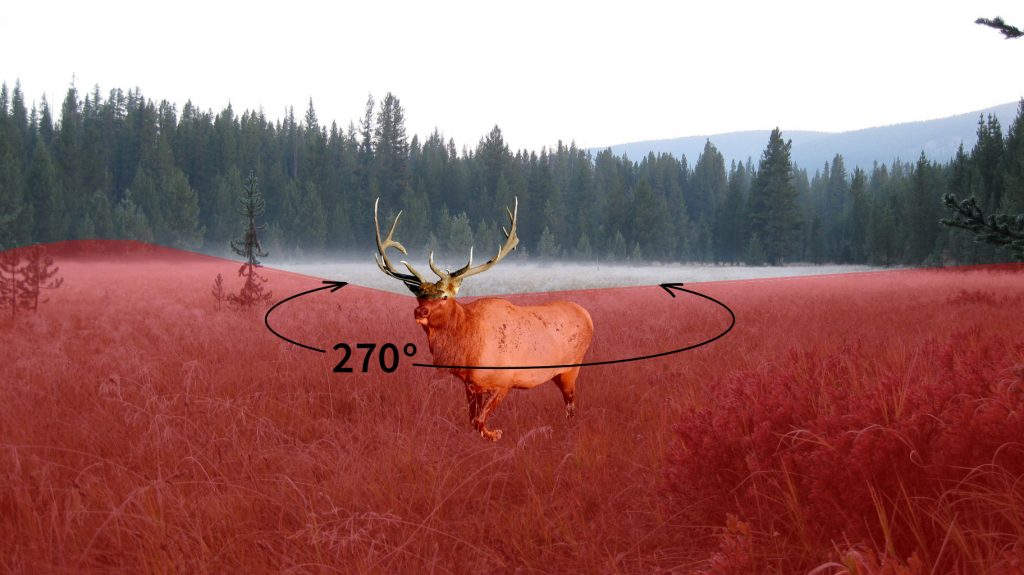
One note I want to stress: always set up in front of brush or trees – never behind. When you set up behind a tree or other obstruction, you have essentially eliminated all shooting lanes by placing a large obstacle directly in front of you. This will make it even more vital that you only move when they elk’s head is blocked from your view.
Again, when it comes to a two-person setup, the caller needs to consider an elk’s sense of sight. It is most effective for the caller to set up in an area that will force the bull to come past the shooter before it gets to the point where it can see the location of the caller. Seeing where the calls are coming from without seeing the source of the calls will often cause the bull to hang up. If he hangs up before he gets into the shooting lane for the shooter, it’s going to be a checkmate.
Smell – The last – and most important – sense to remember when setting up is the elk’s sense of smell. No amount of cover scent or scent control will allow you to go undetected when an elk is directly downwind. In my experience, if you are wearing a cover scent (cow in heat, etc.) and the elk can smell it, the elk can also smell you. A scent eliminating spray might buy you a greater degree of advantage and allow the elk to take a few more steps into a shooting lane before it smells you, but it will never fully conceal you from an elk’s nose. The only sure way to avoid being detected by an elk’s sense of smell is to keep the wind in your favor. Unpredictable thermals in elk country can make that nearly impossible at times, but there are a few things you can do to minimize the effects of Murphy’s Law when it comes to an elk’s senses.
LEVEL THE PLAYING FIELD
There are three advantages to getting on the same level as the elk before you make your final approach and get set up. First, you can eliminate the elk’s visual advantage. An elk will have a visual advantage over you if you approach him from below. Think about the view you have when you stand on a mountain and look down, versus the view you have as you climb the mountain and look up. Visibility is less obscured from a high point, and if an elk has that view, he will often stop and wait to confirm the source of the calling before coming any closer. Secondly, an elk is at a physical disadvantage if it approaches from below you. If a bull is coming to your bugles, you have convinced him that you are another bull elk. If he comes straight up the hill toward you, he will be at a physical disadvantage and putting himself in a dangerous situation. The last thing he wants to do is give his 800-pound adversary a gravitational advantage as he comes in to fight, so pulling a bull up the hill to you can be difficult. Lastly, if thermals are going to switch directions, they will typically do so vertically (180-degree switches). If you are set up directly below an elk with the wind in your favor, when it switches it will likely blow straight up toward the elk. Rarely will the thermals move side-hill for any significant duration, so setting up on the same level as the elk will minimize the chances of being busted by a random change-of-direction by the wind. Getting on the same level as the elk when you set up can eliminate many of the factors that often cause an elk to hang up.THE ARC
The concept of the ‘ARC’ has duel meaning when it comes to setting up on elk. First and foremost, it is an acronym (A.R.C.) that stands for Always Remember Concealment – a constant reminder that you must always consider how you are going to overcome the three senses of the elk when you set up. The second meaning of the ARC refers to a geometric shape – a curved line. Imagine yourself set up on the same level as the elk. Then, draw an imaginary straight line from the caller to the elk. The wind should be moving perpendicular to the line, either up or down. When a bull comes in to your setup, it is unlikely he will charge straight in on that imaginary line. Instead, he will likely follow a slight arc in the direction of the wind. He knows where the caller is, and circling downwind of the caller will allow him to utilize his sense of smell to ensure there is no danger. As the shooter, it is advantageous to set up along that imaginary, downwind ARC, rather than setting up along the straight path. If you are set up on the straight line and the bull circles downwind, he will likely smell you before he is broadside in one of your shooting lanes.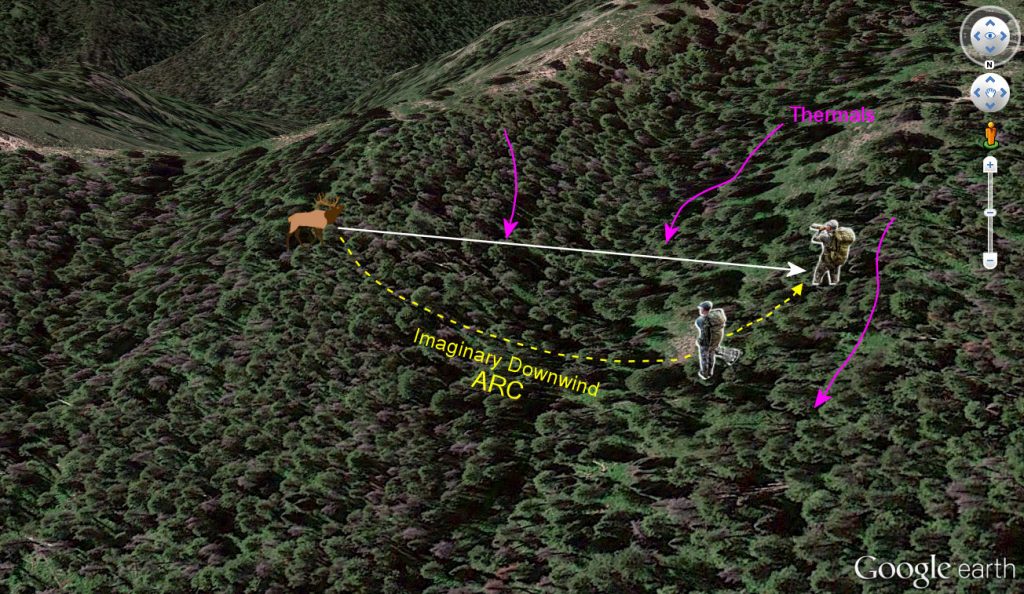
MAKE IT EASY
As I mentioned in the beginning, when an elk feels like it’s able to utilize its senses to detect danger, it’s going to feel more comfortable approaching your calls. If the setup completely prevents the elk from seeing, hearing, and smelling danger, it knows that and will be much more wary, if it decides to come in at all. A comfortable elk is a much easier prey than a cautious, alert elk. When you set up, consider how you can make the elk feel “comfortable” as he comes in. Look for natural trails and paths the elk can follow as he approaches the caller. As the shooter, set up downwind of those natural paths. As the caller, be sure you are drawing the elk along those paths. That might mean moving around to pull the elk in front of the shooter.
Don’t give the elk a reason to hang up or get nervous. If the elk isn’t able to see the location where the calling is coming from, he’s not going to be as likely to stop and look for it. Once it gets to a point where it can see that location though, it’s probably going to stop until it gets a visual confirmation. Use the terrain (call from just behind a ridge, or from inside a thick patch of timber or brush) to pull the bull into the shooter’s setup without allowing the bull to see right where the calls are coming from.
As the shooter, don’t move ahead, and then slip back to set up. If the bull comes to the point where you once stood, he will smell you and not come any closer.
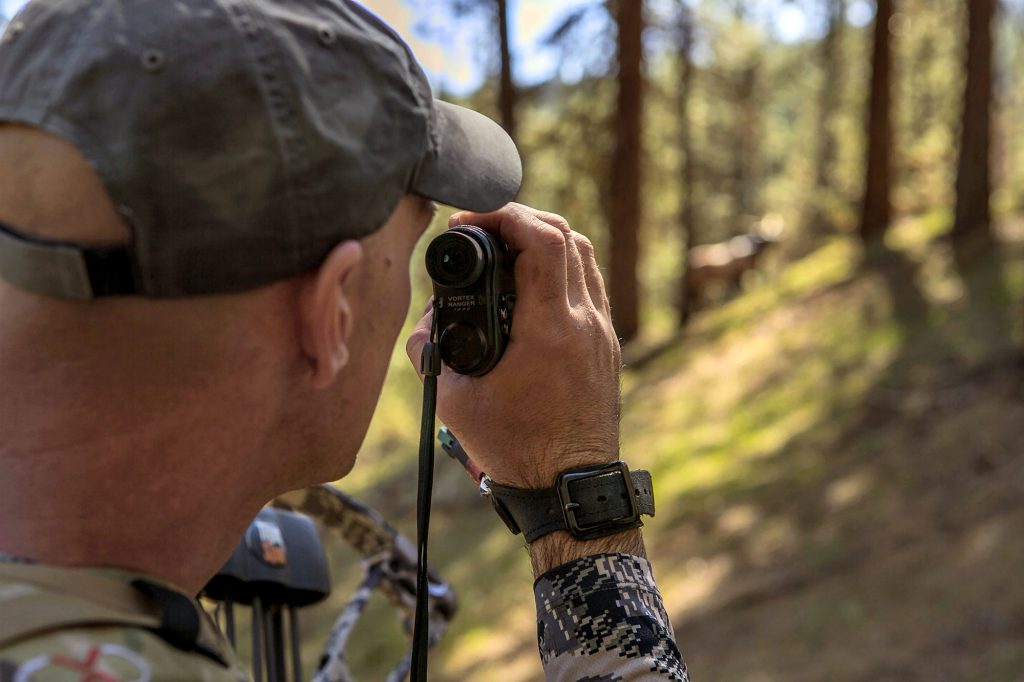
Use a rangefinder to range several surrounding landmarks before the elk comes into your setup. Knowing the distance to a pre-determined tree along the bull’s path before he gets there will give you confidence in your shot and eliminate additional movement while the elk is standing in front of you. Another way to eliminate the lack of confidence in estimating yardages is to attend 3D archery shoots throughout the summer. Even with a rangefinder in your hip pocket, there are times when you won’t have time to use it, so being able to accurately judge distances without the aid of a rangefinder can be quite helpful.
Because I feel that the setup is so critical, I have created the following virtual setup video to help you visualize effective setups. This video will show you the features that will make a setup ideal, as well as highlight some of the obstacles that can cause an elk to hang up or avoid coming into your setup. You’ll also be able to see what an elk is seeing as he comes in to your calls, which will be incredibly helpful as you select your next setup.
Click below to watch the Setup Video:
While the previous video was incredibly helpful at demonstrating what to look for when you are setting up on an elk, it’s still not the same as being there and seeing an actual setup in action. Check out the following video of my 2015 elk hunt in Wyoming to see how we had to adjust our setup to bring the bull in. Once we made a few adjustments, the bull came in on a string!
I’ve mentioned briefly throughout this Chapter, the advantages of the two-person setup. In the next Chapter, I’ll discuss more details related to having a shooter and a caller, and in Chapter 3, I’ll also touch on some things you can do if you are hunting alone.
Click on ‘Next Chapter’ to Continue to Chapter 2: Two-Person Setups





